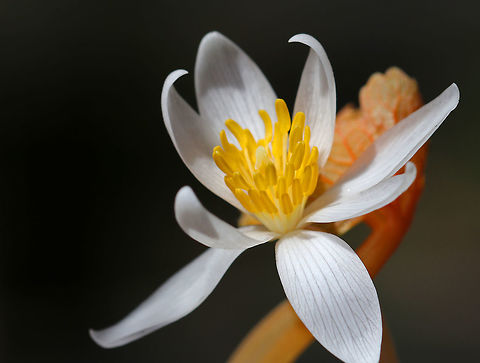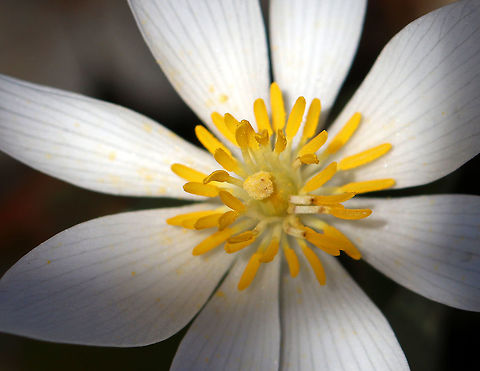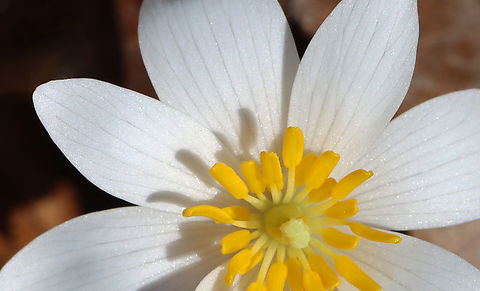
Appearance
Bloodroot grows from 20 to 50 cm tall. It has one large basal leaf, up to 12 cm across, with five to nine lobes. The leaves and flowers sprout from a reddish rhizome with bright orange sap that grows at or slightly below the soil surface. The rhizomes grow longer each year, and branch to form colonies. Plants start to bloom before the foliage unfolds in early spring. After blooming the leaves expand to their full size and go summer dormant in mid to late summer.The flowers bloom from March to May depending on the region and weather. They have 8-12 delicate white petals and yellow stamens, and two sepals below the petals, which fall off after the flowers open. The flower stems are clasped by the leaves. The flowers are pollinated by small bees and flies. Seeds develop in green pods 40 to 60 mm long, and ripen before the foliage goes dormant. The seeds are round and black to orange-red when ripe, and have white elaiosomes, which are eaten by ants.

Distribution
Bloodroot is native to eastern North America from Nova Scotia, Canada southward to Florida, United States, and west to Great Lakes and down the Mississippi embayment."Sanguinaria canadensis" plants are found growing in moist to dry woods and thickets, often on flood plains and near shores or streams on slopes. They grow less frequently in clearings and meadows or on dunes, and are rarely found in disturbed sites. Deer will feed on the plants in early spring.

Habitat
Bloodroot is native to eastern North America from Nova Scotia, Canada southward to Florida, United States, and west to Great Lakes and down the Mississippi embayment."Sanguinaria canadensis" plants are found growing in moist to dry woods and thickets, often on flood plains and near shores or streams on slopes. They grow less frequently in clearings and meadows or on dunes, and are rarely found in disturbed sites. Deer will feed on the plants in early spring.Bloodroot is one of many plants whose seeds are spread by ants, a process called myrmecochory. The seeds have a fleshy organ called an elaiosome that attracts ants. The ants take the seeds to their nest, where they eat the elaiosomes, and put the seeds in their nest debris, where they are protected until they germinate. They also benefit from growing in a medium made richer by the ant nest debris.
The flowers produce pollen, but no nectar. Various bees and flies visit the flowers looking in vain for nectar, for instance sweat bees, cuckoo bees, small carpenter bees, and bee flies. Some bees come to collect pollen, including mining bees, which are the most effective pollinators.

Defense
Bloodroot produces benzylisoquinoline alkaloids, primarily the toxin sanguinarine. The alkaloids are transported to and stored in the rhizome.Sanguinarine kills animal cells by blocking the action of Na+/K+-ATPase transmembrane proteins. As a result, applying bloodroot to the skin may destroy tissue and lead to the formation of a large scab, called an eschar. Bloodroot and its extracts are thus considered escharotic. Applying escharotic agents, including bloodroot, to the skin is sometimes suggested as a home treatment for skin cancer, these attempts can be severely disfiguring. Salves derived from bloodroot cannot be relied on to remove an entire malignant tumor. Microscopic tumor deposits may remain after visible tumor tissue is burned away, and case reports have shown that in such instances tumor has recurred and/or metastasized.
Internal use is not recommended. An overdose of bloodroot extract can cause vomiting and loss of consciousness.

Uses
Commercial uses of sanguinarine and bloodroot extract include dental hygiene products. The United States FDA has approved the inclusion of sanguinarine in toothpastes as an antibacterial or anti-plaque agent....hieroglyph snipped... However, the use of sanguinaria in oral hygiene products is associated with the development of a premalignant oral leukoplakia,which may develop into oral cancer. On 24 Nov 2003, the Colgate-Palmolive Company of Piscataway, New Jersey, United States commented by memorandum to the United States Food and Drug Administration that then-proposed rules for levels of sanguinarine in mouthwash and dental wash products were lower than necessary. However, this conclusion is controversial.Some animal food additives sold and distributed in Europe contain sanguinarine and chelerythrine.
References:
Some text fragments are auto parsed from Wikipedia.